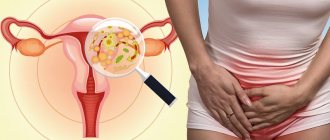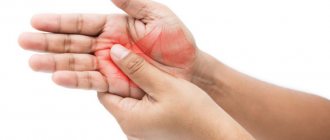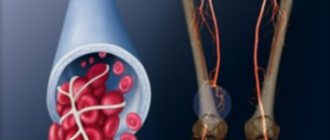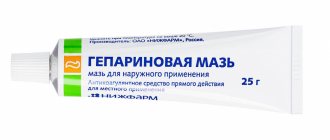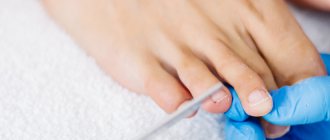Lumbar ischialgia is a term denoting pain in the lower back with irradiation into the buttock, into the leg, along the back of the leg. Pain may be accompanied by numbness and tingling in the area of innervation of the sciatic nerve. The term lumboischalgia (synonymous with lumbosacral radiculitis) refers only to pain syndrome and is not a diagnosis.
Luboischialgia is characterized by one or more symptoms:
- Constant pain only in the buttock or thigh on one side (less often in both legs)
- Pain worsens when sitting
- Burning or tingling sensation spreading down the leg
- Weakness, numbness, or loss of movement in the leg
- Constant pain on one side
- Severe pain that may make it difficult to stand or walk
Pain syndrome with lumbar ischialgia can be of varying intensity depending on the underlying disease that led to the development of lumbar ischialgia. Symptoms of lumbar ischialgia are caused by irritation of the sciatic nerve.
The sciatic nerve is the largest nerve in the torso and is made up of individual nerve roots that originate in the lumbar spine (at L3) and collectively form the “sciatic nerve.” The sciatic nerve runs from the lumbar spine to the leg. Parts of the sciatic nerve then branch in each leg and innervate specific parts of the leg - buttocks, thighs, calves, feet, toes.
Symptoms of lumbar ischialgia (lumbosacral radiculitis) such as pain in the leg, numbness, tingling, weakness may vary depending on where the nerve compression occurs.
The incidence of lumboischalgia (lumbosacral radiculitis) increases in middle age. Lumbar ischialgia rarely occurs under the age of 20; such pain syndromes are most likely at the age of 40-50 years, and in the older age group the likelihood of lumbar ischalgia decreases.
Often, specific events or injuries do not cause inflammation of the sciatic nerve, but over time the damage leads to the development of sciatica. In most patients, conservative treatment can be quite effective, and the pain syndrome decreases significantly within a few weeks, but in a certain number of patients the pain syndrome may be persistent.
Causes of leg pain
As already mentioned, the reasons why legs hurt can be very different. They can be caused by a number of diseases, the first of which is vascular. They are followed by diseases of the spine and inflammation of muscle tissue.
At CELT you can get advice from a specialist algologist.
Make an appointment
Vascular diseases of the legs
Diseases of the blood vessels of the legs, which are characterized by pain symptoms localized in the legs, include:
- varicose veins - characterized by dull, aching pain, which is accompanied by heaviness in the legs and cramps in the calf muscles;
- thrombophlebitis - characterized by constant pain that is pulsating in nature; often they turn into a burning sensation under the skin, especially with this disease the calves of the legs hurt;
- thrombosis - characterized by unexpected sharp pain and accompanied by heaviness, a feeling of fullness and swelling;
- obliterating atherosclerosis of the lower extremities - characterized by pain in the calf muscles of the legs and thigh muscles (this is especially evident when walking and subsides when moving);
- Leriche syndrome - characterized by intermittent claudication and pain in the left or right leg.
Spinal diseases
Spinal conditions that cause leg pain include:
- lumbar osteochondrosis - degenerative processes occurring in the spine cause radiating pain;
- herniated disc in the lumbar region - characterized by pain radiating to the buttock and the entire leg up to the foot, accompanied by burning, numbness of the limb and tingling;
- sciatica is a pain symptom caused by pinched nerve endings, the sciatic nerve.
Muscle tissue diseases
Muscle tissue diseases that cause pain in the leg muscles include:
- myositis, which can have an infectious etiology, and also develop due to overload;
- myoenthesitis, which is caused by excessive professional physical activity;
- Fibromyalgia, which mostly affects women and is characterized by widespread muscle pain in one or both legs.
Pain in the above diseases starts from the hips and “goes down”; sometimes convulsive syndrome occurs.
Joint diseases
Speaking about diseases that cause pain in the legs, one cannot fail to mention the following:
- different types of knee arthritis;
- degenerative diseases of the hip joint (coxitis, coxarthrosis);
- gout of the legs - gnawing pain, worsens at night; throbbing pain in the big toe;
- erysipelas.
Treatment
In most cases, conservative treatment of lumbar ischialgia is quite effective. The range of treatment methods for lumbar ischialgia is wide and is aimed at reducing compression of the nerve roots and reducing pain. The most effective is the use of an integrated approach to the treatment of lumbar ischialgia and the use of a combination of various treatment methods (physiotherapy, massage, manual therapy, drug treatment, acupuncture and exercise therapy).
Drug treatment . The use of anti-inflammatory drugs (ibuprofen, naproxen, voltaren), COX-2 inhibitors (Celebrex) can reduce inflammation, which leads to a decrease in pain.
Epidural injections . If severe pain is present, an epidural steroid injection may be given. Epidural steroid administration differs from oral steroid administration in that the drugs are injected directly into the painful area around the sciatic nerve, which can quickly reduce inflammation and relieve pain. The effect of such a procedure is usually temporary, but it helps to relieve severe pain quite quickly.
Manual therapy
Modern gentle manual therapy techniques make it possible to restore the mobility of the motor segments of the spine, remove muscle blocks, improve the mobility of the facet joints and can sometimes significantly reduce compression of nerve fibers.
Acupuncture also helps reduce pain and restores conduction through nerve fibers.
Massage
Therapeutic massage methods can improve microcirculation, relieve muscle spasms, and also increase the body's production of endorphins.
Physiotherapy . Existing modern methods of physiotherapy (cryotherapy, laser therapy, ultrasound, electrophoresis) can reduce inflammation, improve blood circulation and thus reduce pain.
Exercise therapy . Physical exercises, which need to be included after pain has been reduced, allow you to restore the muscle corset and normalize the biomechanics of the spine, improve blood circulation in the motor segments. Physical exercises include both mechanotherapy (exercises on machines) and gymnastics, which allows you to develop both muscles and strengthen the ligamentous apparatus. Exercises for lumbar ischialgia must be selected with a physical therapy doctor (instructor), since independent exercises often lead to a relapse of symptoms.
Surgery
Indications for surgical treatment are the following factors:
- Severe pain in the leg that lasts for more than 4 to 6 weeks.
- Lack of effect from conservative treatment and persistence or worsening of neurological symptoms.
- Pain syndrome significantly impairs the patient's quality of life and the patient's ability to participate in daily activities
Urgent surgery is usually only necessary if there are progressive neurological symptoms (increasing weakness in the legs or sudden loss of bowel or bladder function).
Our doctors
Diagnosis of pain includes:
- collecting an anamnesis about the localization and nature of pain, its manifestation in the other leg, depending on the time of day, body position, state of rest and stress, as well as the symptoms that accompany it;
- Conducting a visual examination with tests, palpation and checking reflexes;
- conducting an ultrasound examination of the vessels of the sore leg;
- performing radiography;
- MRI, which allows you to determine the condition of blood vessels, cartilage and bone tissue;
- radionuclide scanning, which allows you to examine the skeletal system;
- a number of laboratory tests.
If necessary, an ultrasound of the abdominal organs is performed to identify abnormalities in the functioning of the kidneys and liver.
Burning symptoms
The burning sensation may be accompanied by other symptoms, which vary depending on the underlying disease, disorder or condition. They often affect the limbs and are also associated with various body systems.
Signs that may occur along with a burning sensation in the extremities:
- bleeding;
- formation of blisters from burns;
- numbness;
- pain;
- redness, warmth, or swelling;
- tingling;
- touch sensitivity.
Serious signs that indicate a life-threatening health condition are a sudden burning sensation in the extremities, accompanied by numbness or weakness on one side of the body. This symptom may be a sign of a stroke. If this occurs, seek immediate medical attention if you experience this sensation along with other serious symptoms.
A few other signs that may follow numbness or "hot" sensations in the extremities: a change in mental state known as confusion; rave; lethargy; hallucinations and delusions; slurred speech; sudden change in vision; loss of vision or eye pain; Strong headache. A burning sensation in this case indicates a stroke. If you feel a similar feeling in your body, it may be caused by damage to the nerve or skin in the surrounding tissues. Burns from chemicals or extreme heat, or exposure to toxic substances can damage nerves in the skin, resulting in a burning sensation.
What you need to know about diagnostics
A visit to the doctor is the most reasonable solution when your knees are burning and it’s unclear what to do. Characteristic symptoms and visual examination often make it possible to make a preliminary diagnosis and take the necessary measures to alleviate the patient’s situation. But in most cases, the doctor prescribes a comprehensive examination to determine why the discomfort appeared. In addition to tests, additional types of diagnostics may be prescribed - x-rays, ultrasound, computed tomography. In some cases, specialists from related fields are involved in the examination - oncologist, dermatologist, surgeon.
It is important to remember that a simple burning sensation in the knee may hide a serious illness. If you waste time and do not seek medical help when the first unpleasant symptoms appear, the consequences may be irreversible. If it is difficult to determine what it means when your knee pinches, you cannot risk your health; you need to undergo a full medical examination as soon as possible. After all, knee problems are usually just one of the symptoms of various diseases. The sooner they are diagnosed, the higher the likelihood of completely getting rid of the disease.
How does the disease manifest?
Alcoholic polyneuropathy has a set of characteristic symptoms that gradually become more pronounced:
- the muscles of the arms and legs become weak. At first, mild weakness is felt in the palms and feet, and then spreads and becomes more noticeable;
- decrease in sensitivity, its gradual decrease until disappearance;
- decrease in the severity of reflexes up to their absence;
- pain syndrome. The pain may increase gradually or be immediate and severe. Usually pain is not associated with any “external” causes (injuries, stress);
- swelling of the legs, arms;
- the appearance of goosebumps, burning, and other sensations in the limbs;
- tremors, tics, muscle twitching, finger trembling;
- problems with the cardiovascular and respiratory systems (shortness of breath, breathing problems, rapid pulse, arrhythmia);
- sweating (appears unexpectedly and is not associated with exercise, body temperature or heat);
- impaired coordination of movements, dizziness, problems with balance.
Symptoms can increase sharply after severe alcohol intoxication or binge drinking; they often manifest themselves acutely after hypothermia. In other cases, they intensify gradually, against the background of a general deterioration in health due to chronic alcohol dependence. More often, the disease develops subacutely over several weeks or months: the sensitivity of the arms or legs is impaired, and the calf muscles become painful. When squeezed, the pain intensifies. Without treatment, muscle weakness appears - up to paralysis and atrophy.
Order alcoholism treatment
We work around the clock, experienced doctors, 100% anonymous.
What measures should be taken for numbness?
If the causes of numbness are external, you can cope with them on your own. For example, change your shoes to something more spacious that doesn’t squeeze your toes and feet. If the reason is an uncomfortable position, large vessels may be squeezed, causing the fingers to go numb. Changing your posture will solve this problem too.
Light massage movements, as well as baths in which warm water will alternate with cold, will help restore blood circulation and restore sensitivity to the fingers. Exercise and morning jogging will also help improve blood circulation.
You should also pay attention to your diet. It should contain a sufficient amount of foods containing vitamins B6 and B12. These are eggs, chicken and quail, meat, milk, cereals, legumes, sprouted wheat. It is better not to abuse coffee and strong black tea. But it is advisable to get rid of bad habits altogether.
What and how to treat knees
Relieving burning and pain is only the first step towards restoring health. More precisely, helping the body get rid of unpleasant sensations. However, often this has nothing to do with the treatment of the disease itself. When the doctor knows that fever in the knees is a consequence of one or another pathology, a full course of treatment is prescribed, which may include:
- massage;
- physiotherapeutic procedures;
- therapeutic exercises;
- use of medications.
If we are talking about serious damage to the knee joint caused by injuries or diseases of the musculoskeletal system, surgical intervention is indicated. Most often, this is endoprosthetics - an operation in which a joint is partially or completely replaced with a prosthesis. Modern technologies make it possible, with the help of such an operation, to completely restore the mobility of the lower extremities and return patients to a full life.
Surgical intervention with prosthetics is also indicated in the case of cancer, when bones and joints are damaged as a result of metastases. Just a few decades ago, with such a diagnosis, the only way out of the situation was amputation of limbs.
Today, joint replacement is a simple, effective and minimally invasive way to solve problems for people who are faced with cancer.
Primary diagnosis and assistance before visiting a doctor
Injuries, skin diseases, inflammatory processes, and frostbite are quite easy to diagnose on your own, since the signs of pathology will be obvious. In each specific case, first aid will be different. In case of bruises, it is necessary to ensure immobility of the joint by using a tight bandage and apply ice to avoid swelling. If the causes of burning and a local increase in temperature are associated with mild frostbite, you need to get into a warm room as soon as possible, and then apply a thermal insulating bandage to the problem area.
If it is unknown why the knees are burning, but the patient suffers from any dermatological diseases or allergies, first aid will consist of taking antihistamines or treating the skin in the joint area with creams against psoriasis and dermatitis. In case of inflammatory processes, when the knees are burning, and it is known for sure that this is a consequence of an infectious disease, it is necessary to urgently take antibiotics.
What to do if your knee hurts and burns due to increased physical activity? First of all, immobilize the joint and minimize activity. However, immobility is only a temporary measure, not a panacea. Moreover, complete lack of physical activity for a long period can worsen the situation.
If it is not clear why your knees turn red, but there is pain and discomfort in the knee joints, you can resort to universal remedies - ointments and tablets that will help relieve discomfort. But we must remember that this is not a treatment, but only an auxiliary measure. Only a specialized specialist can determine why your knees are burning and prescribe a course of treatment.
